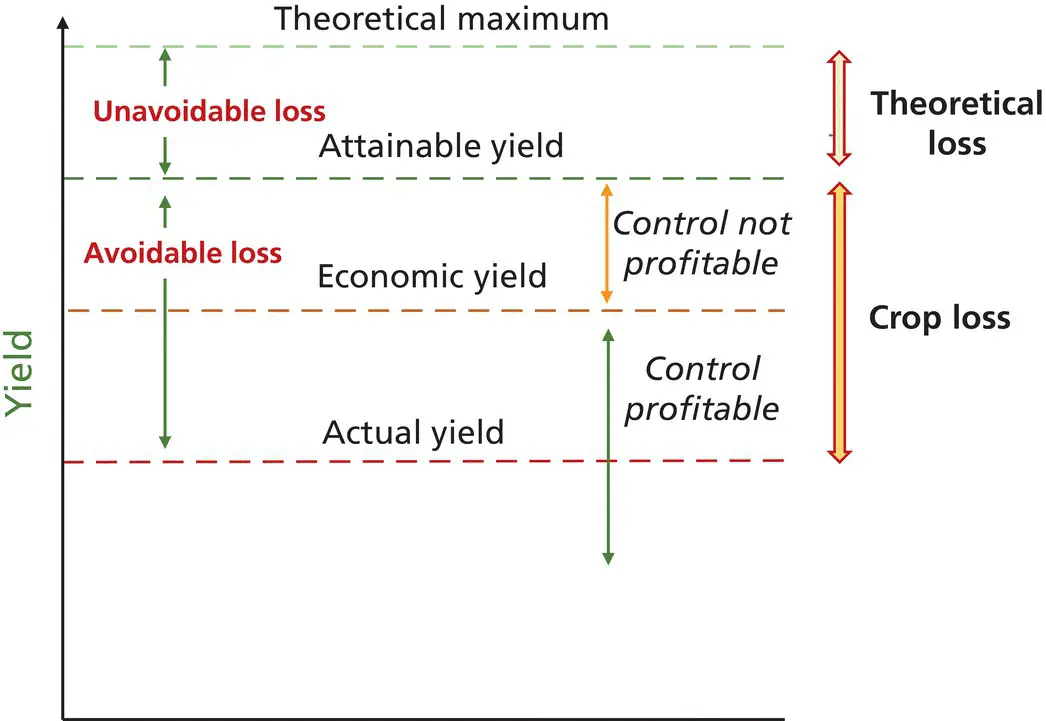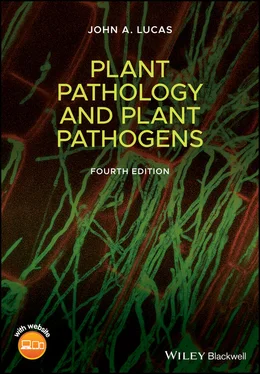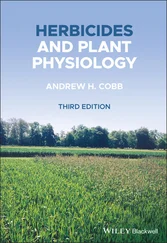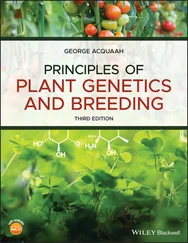The relationship between the amount of disease and loss of income is complex due to the many possible interactions between symptoms of disease and the final determinants of crop yield and quality. Figure 1.8defines a number of yield levels for a hypothetical crop. The theoretical maximum yield is a value based on predictions from crop physiology; under field conditions, this yield level is not a practical possibility and hence there is some unavoidable loss. Attainable yield indicates the maximum level to be expected under optimum conditions in the field. With optimum inputs of fertilizer, water, and pesticides, this is the best yield the farmer can realistically hope for. The difference between this value and the actual yield (also described as farmer yield) obtained from the crop can be defined as an avoidable loss. In practice, attainable yield is not a realistic goal for most crops for simple economic reasons. To increase yield to this level requires so many inputs that the cost is greater than the eventual return at the end of the season. Instead, we can define a slightly lower threshold, the economic yield, which represents the break‐even point at which the input cost is balanced by the extra productivity of the crop. Any shortfall below this level is an avoidable loss which justifies the expense of a control measure.

Figure 1.8 Relationship between yield levels and crop loss, indicating economic benefits of control.
Source: Zadoks and Schien (1979).
For some crops, especially high‐value fruits, vines, vegetables or ornamental plants, the quality of the product is as important as the yield. Under these circumstances, very little disease is tolerated, as any damage or blemish may have a disproportionate effect on crop value. Not surprisingly, the most intensive disease and pest control regimes available are used for such crops.
The impact of plant disease depends on agricultural, biological, socioeconomic, and historical factors. In developed agricultural systems, impacts are usually measured in terms of reduced crop yield and quality, and overall effects on farm profitability. In less developed systems, the consequences of disease can be much more serious, affecting food security, regional and national economies, and social stability. Invasive pests and pathogens can also destroy native trees and alter natural ecosystems, as well as impacting on biodiversity ( Table 1.4).
Some examples of these impacts and the pathogens responsible are given in Table 1.5. Prior to understanding of the germ theory of disease, and discovery of chemicals and other means of controlling epidemics, disease outbreaks could devastate crops and consequently cause famine and social disruption. It is believed that a plant disease, most likely a virus, contributed to the collapse of the ancient Mayan civilization in the ninth century. But the most notorious case is the potato late blight outbreak of 1845–1846, caused by the oomycete pathogen Phytophthora infestans , that spread rapidly across Europe and had particularly disastrous consequences in Ireland, where many communities were dependent on potatoes as their sole source of food. Around 1 million people died of starvation and countless others were displaced, many emigrating to the USA. Fortunately, with diversification of food sources, and improved crop protection, this scenario is now much less likely to be repeated in developed countries, but in subsistence agriculture is still a constant threat.
Table 1.4 Some impacts of plant disease
| Developed agriculture |
| Reduced crop yield |
| Reduced crop quality |
| Compromised product safety, e.g., mycotoxin contamination |
| Reduced profitability |
| Developing agriculture |
| Food security – malnutrition and famine |
| Impact on communities or national economies |
| Social instability |
| The natural environment |
| Loss of key species or natural communities |
| Damage to landscapes and leisure amenities |
Table 1.5 Some examples of the impacts of specific plant diseases
| Type of impact |
Disease |
Causal agent |
Country/region affected |
| Famine |
Late blight of potato |
Phytophthora infestans |
Europe 1845–1846 |
| Brown spot of rice |
Helminthosporium oryzae |
India 1942–1943 |
| Failure of maize crop |
Maize mosaic virus? |
Guatemala, ninth‐century Mayan civilization |
| Cassava mosaic disease |
Cassava mosaic Gemini viruses |
East Africa 1980s to present |
| Economic |
Coffee rust |
Hemiliea vastatrix |
Sri Lanka 1870, now worldwide |
| Cocoa swollen shoot |
Cocoa swollen shoot virus |
Ghana/Nigeria 1930–present |
| Citrus canker |
Xanthomonas axonopodis pv. citri |
Florida 1912, 1986, 1995–present |
| Agricultural |
Southern corn leaf blight |
Bipolaris maydis |
USA 1970 |
| Asian soybean rust |
Phakopsora pachyrhizi |
Asia 1900s, Africa 1995, Brazil 2001, USA 2004 |
| Black stem rust |
Puccinia graminis f.sp . tritici |
USA 1900s, new race Ug99 in Africa 1999, now Middle East and potentially Asia |
| Ecological |
Dutch elm disease |
Ophiostoma novo‐ulmi |
Northern hemisphere 1930, 1970–present |
| Jarrah dieback |
Phytophthora cinnamomi |
Western Australia 1920–present |
| Sudden oak death |
Phytophthora ramorum |
California 1995, UK 2002 |
| Ash dieback |
Hymenoscyphus fraxineus |
Poland 1990s, western Europe, UK 2012 |
A more recent example is the spread of cassava mosaic disease (CMD) in Africa. A severe outbreak emerged in Uganda in the 1980s, with crop losses as high as 80–90%, and cultivation of this vital food crop was abandoned in some areas. CMD, that is now known to be caused by a complex of related Gemini viruses spread by whitefly vectors, has since invaded other countries in sub‐Saharan Africa where it continues to affect food security. Recently, a different virus, cassava brown streak, has spread to East Africa to pose a further threat to this vital staple crop.
Other diseases have had serious economic impacts, such as coffee rust that devastated the industry in Sri Lanka and has now spread worldwide. More recent examples of global pandemics caused by rust fungi include Asian soybean rust, that has now spread to the major producing areas in Brazil and the USA, and black stem rust of wheat, a new variant of which (Ug99) emerged in Africa and is now spreading east, threatening wheat production areas in Asia. Soybean producers in the Americas now have to factor in the cost of fungicide treatments, while there are concerns that Ug99 might decrease wheat production in affected countries.
A further consequence of disease is the impact of measures taken to control pathogens that threaten export markets. Attempts to eradicate the destructive cocoa swollen shoot virus (CSSV) from Ghana by means of statutory removal of infected and surrounding trees not only entailed the most costly eradication campaign ever attempted, but also lead to political unrest. In the USA and South America, spread of the bacterial disease citrus canker has only been contained by burning huge numbers of infected citrus trees and nursery stock, combined with vigilant quarantine measures. In Florida, this included removing asymptomatic citrus trees from private gardens within affected areas, which inevitably brought plant health authorities into conflict with home owners. Outbreaks of crop diseases can also impact on agricultural practices and policy. The major epidemic of southern corn leaf blight in the United States in 1970 (see Chapter 5, Figure 5.1) raised doubts about the wisdom of achieving genetic uniformity in modern cereal crops and forced a reassessment of the breeding methods employed in the production of new cultivars.
Читать дальше












